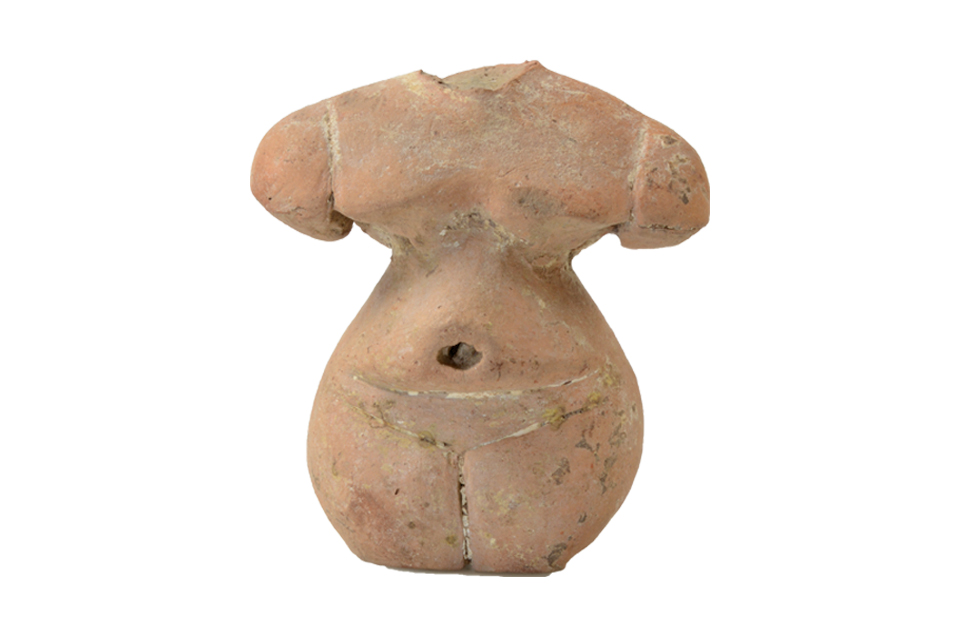Exhibit of the month
Eight thousand years ago: the hidden face of the Neolithic child
Clay figurine of pregnant woman
National Archaeological Museum
Collection of Prehistoric Antiquities, inv. no. Π 16485
Provenance: Thessaly, George Tsolozidis Collection
Measurements: Height: 5,5 cm.
Chronology: Middle Neolithic period (5800-5300 BC)
Display place: Permanent Exhibition of Neolithic Antiquities, Room 5, Showcase 9.
Thessaly having been systematically inhabited throughout the Neolithic period (6800-3300 BC), with numerous settlements already in the Middle Neolithic period (5800-5300 BC), offers us a rich panorama of clay figurines depicting humans. In the permanent exhibition of the National Archaeological Museum a series of Thessalian figurines is on display[1], where the fat female figures prevail, indeed quite a few of them pregnant, as the one discussed here[2]. What stands out is the naturalistic rendering of certain features of a woman’s body and appearance (youthful and saggy breasts as age indicators, deformations, but also hairstyles-garments), while the face is conventionally depicted.
The cultural intention for the individualization of situations and stages in life, is particularly evident in the detailed morphology of every pregnant woman’s belly, as the uniformly rounded belly of the figurine under discussion, the raised ‘pointed’ belly, the low ‘pointed’ belly [3]. Even if figurines were depicting some ‘divine’ figures, the observation of the variety in belly shapes during pregnancy was conducted on common mortal women. But how was it possible for women in agricultural Neolithic societies, with so much manual work, to be so fat? It is probable that when females reached the reproductive phase in their life were becoming so important that care was taken by their community to supply them with greater quantities of food so as to accumulate fat and be able to carry through a full-term pregnancy and deliver a healthy child[4].
In contrast to female, male figurines are much fewer. Among them stands out the clay statuette of the ‘Thinker’, who declares his fertilizing power over nature itself.[5] The Neolithic society, through female and male figurines, alludes to the fact that it multiplies and perpetuates itself, but does not portray children as distinct members of it, with just a few exceptions, such as the Mother, who holds her child in her arms, without showing us its face and the small figurine most probably of a baby in the clay house model from Platia Magoula Zarkou, in Trikala, Thessaly.
Why was that the case with children we do not know. We do know though that in later times there are figurines which illustrate other moments from the life of women and children; figurines that continue to express the fertilizing power, depicting the birth of a child as a most meaningful event, not only in the life of a woman but of society in its entirety, as a collective wish for a successful outcome, being aware of the high risk involved in delivering a baby.
[1] The bulk of clay figurines come from Christos Tsountas’ excavations in the early 20th century in the settlements of Sesklo and Dimini in Thessaly. Moreover, quite a few figurines come from George Tsolizidis Collection of Thessalian provenance.
[2] Figurine Π16485 is fashioned with the use of the core technique, as shown on its back side, where the buttocks and thighs have been modelled around two perpendicular cylinders of clay.
[3] Figurine Π5944 bears two incisions-scars, described by Tsountas (1908, p. 292), “on either side there are two scars incised when the clay was still wet and with their outline painted red, undoubtedly indicating wounds that have healed”. This is a cultural manner of symbolism, by means of scarring the body itself, the meaning of which is not known to us, but similar bloody procedures to mark out on the body major events, such as someone’s coming of age, are to be encountered in African traditional societies even today.
[4] Women with malnutrition may experience irregularity in their circle and hence fertility issues, while fat reserves in the body facilitate women to go through periods of food shortages. Manteli 2018, p. 328.
[5] Hesiod, Theogony (175-200). Uranus’ cut-off genitals and blood fertilized the earth and the sea and thus Aphrodite was born.
Dr. Katia Manteli
BIBLIOGRAPHY
Manteli Katia, 2018. «Figurines as holograms of beauty in the Neolithic culture of Greece: Rendering the human figure», in Maria Lagogianni-Georgakarakos (ed.) The Countless Aspects of Beauty in Ancient Art. Athens: TAPA, pp. 321-331.
Τσούντας Χρήστος, 1908. Αι Προϊστορικαί Ακροπόλεις Διμηνίου και Σέσκλου. Athens: The Archaeological Society at Athens Library.
Χουρμουζιάδης Γιώργος Χ., 1994. Τα νεολιθικά ειδώλια. Thessaloniki: Vanias Publications.
Biehl, P. F., “Children in the anthropomorphic imagery of the European and Near Eastern Neolithic”, in T. Guner Coskunsu (ed.) The Archaeology of Childhood. Interdisciplinary Perspectives on an Archaeological Enigma, State University of New York Press, 2015, pp. 189-216:198.
Gallis, K. J. 1985, “A Late Neolithic Foundation Οffering from Thessaly”, Antiquity 59, pp. 20-24.
Nanoglou, S., 2005, “Subjectivity and material culture in Thessaly, Greece: the case of Neolithic anthropomorphic imagery,” Cambridge Archaeological Journal, 15 (2), pp. 141-156.
Papadopoulos, C., Y. Hamilakis, N. Kyparissi-Apostolika & M. Diaz-Guardamino, 2019, “Digital Sensoriality: The Neolithic Figurines from Koutroulou Magoula, Greece”, Cambridge Archaeological Journal, 29 (4), pp. 625-652.


